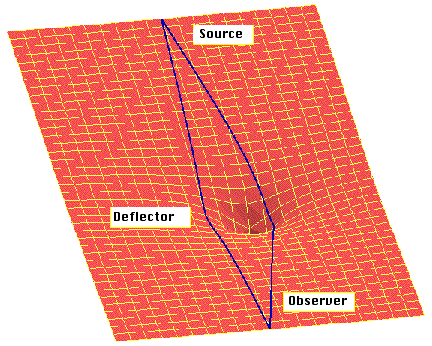
Gravitational lensing refers to how light travel is modified by the presence of mass. The idea is that in empty space, light travels in a straight line, BUT is deflected from a straight line when traveling past a body of mass. (When that body of mass is a black hole, and if the light passes close enough, this deflection is "catastrophic" in that the light can pass into the black hole never to get out again.)
Actually, it is more accurate to say that light always travels in a straight line (or rather, follows the shortest path between two points) and it is space itself that becomes distorted by the presence of mass so as to make it appear that light moves along a curved path. This next figure illustrates the point.

Now every body of mass can contribute to the deflection of light. However, it turns out that light is fast and gravity is weak! Substantial lensing requires the close passage of light to a significant concentration of mass.
Examples of lensing have become almost commonplace in astronomy, not because significant lensing itself is so common, but rather because there are so many sources and intervening bodies of mass, and because technology is such that we can now monitor large numbers of sources and are capable of seeing distant faint objects. On the whole it is pretty hard work!
A nice example of strong lensing is given in the following image that was taken by the Hubble Space Telescope. The "lens" consists of the cluster of bright galaxies. The galaxies are the bright, generally round objectsexample of strong lensing is given in the following image that was taken by the Hubble Space Telescope. The "lens" consists of the cluster of bright galaxies. The galaxies are the bright, generally round objects. What is being lensed are other more distant galaxies that lie behind this cluster (perhaps 5 to 10 times more distant). The gravitational lensing leads to the fainter and elongated "streaks" (like arcs), which are the distorted images of these distant galaxies.
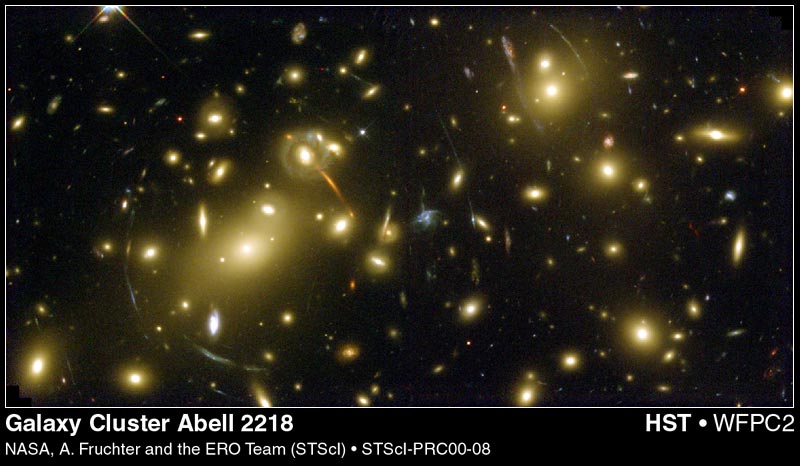
So how are we to think of this lensing? What is the light doing? The next two figures illustrate the trajectory taken by light when it is lensed, in the first case where the observer, lens, and distant source all lined up, and in the second case where the alignment is not quite perfect.


In the first case, the image of the distant source is distorted into a perfect ring. In the second two arc-like images are produced.
What happens if the arrangement evolves? Nothing in the Universe is sitting still - everything moves. For the example of the cluster of galaxies above, the distances are so large that the arrangement will not change much in our lifetime (or many lifetimes!). However, lensing does occur in the vicinity of our galaxy, involving a stellar source and some other body of matter acting as a lens. In this case the alignment can vary significantly over weeks and months. The following shows how the lensing changes over time, with the lens as the dark point at the middle, taken as fixed, and the source a more distant star shown as an open circle that tracks from left to right.
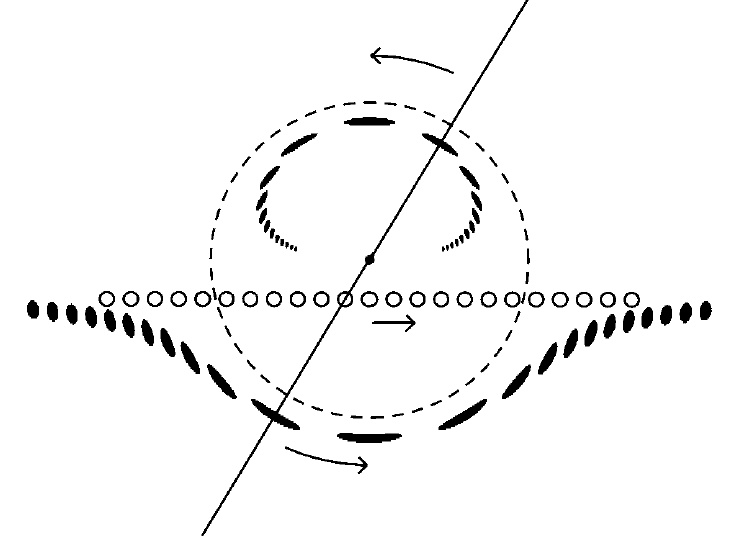
Two images are produced, shown as filled dark ovals. The two are oppositely oriented about the lens and source, such that the images, the lens, and the star all line up (an example line is provided). The dashed circle is the "Einstein radius". If everything were perfectly aligned, the image of the star would appear as a ring of brightness along this circle.
Although this picture is correct, this kind of lensing involves masses like that of stars instead of galaxies, and separation of the two images depends on the mass. Since the masses are relatively small, the images are relatively close, too close to be observed distinctly with telescopes.
Although the separate images cannot be discerned in this case, the brightness of the distant source does change, in particular it brightens or is amplified. This kind of lensing is called "microlensing". The following light curve, in blue and red light, shows how microlensing causes a star to brighten for a time (the lower axis is in days, and the vertical is an amplification factor, for which "1" means no lensing).
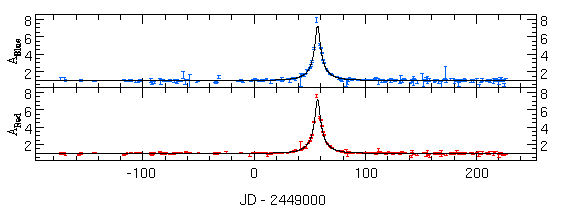
Here is another example of a light curve from microlensing.
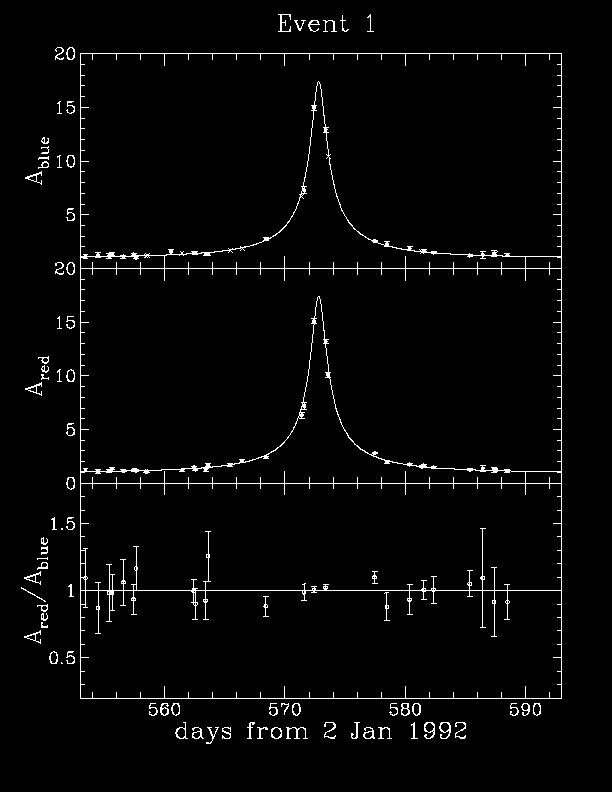
In this case a ratio of the of the blue and red amplifications is also shown. A characteristic of true microlensing, instead of some other stellar variability, is that lensing does not depend on the type of light (well, at least in the simple case), thus the ratio of amplifications for different colors should always be one.
The following graph shows lightcurves for many microlensing candidates that were observed in the direction of the Galactic Bulge, all overplotted to show the range of lensing durations.
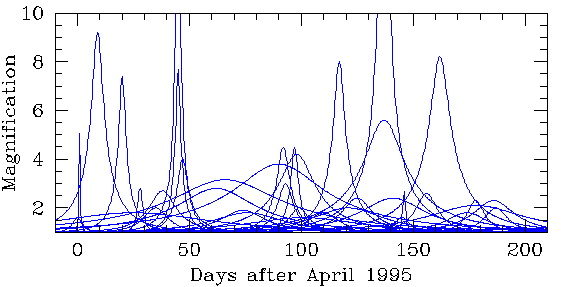
The following illustration shows the three main microlensing survey efforts in our "neighborhood".
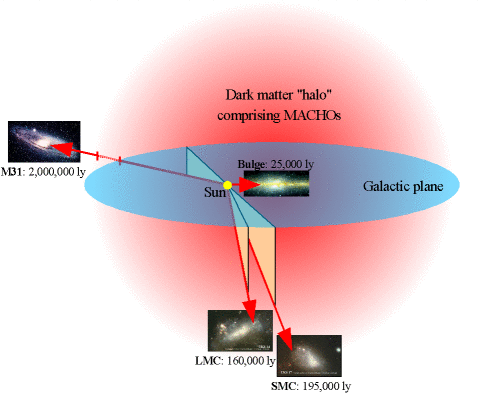
Concerted efforts to monitor multiple millions of stars have resulted in only upwards of 1000 microlensing events. A lot of events to be sure, but requiring an immense observational and organizational expense!
So gravitational lensing has become an important area of study in astrophysics, both in our galaxy in reference to the problem of "Dark Matter" and in explorations of the Universe as a whole.
The following link provides some animations of lensing by Dr S. Gaudi.